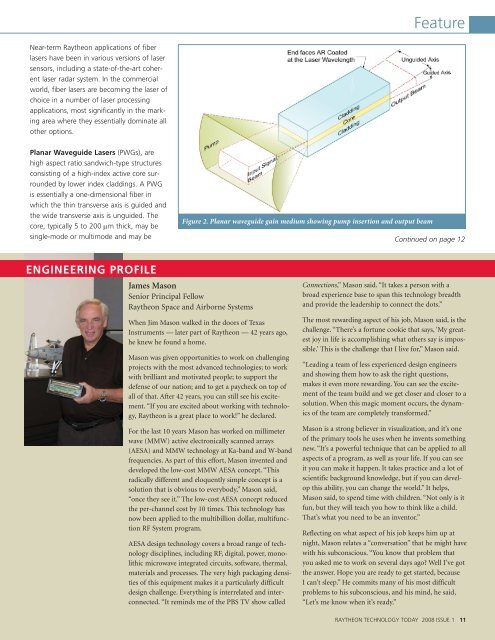Technology Today issue 1 2008 - Raytheon
Technology Today issue 1 2008 - Raytheon
Technology Today issue 1 2008 - Raytheon
You also want an ePaper? Increase the reach of your titles
YUMPU automatically turns print PDFs into web optimized ePapers that Google loves.
Near-term <strong>Raytheon</strong> applications of fiber<br />
lasers have been in various versions of laser<br />
sensors, including a state-of-the-art coherent<br />
laser radar system. In the commercial<br />
world, fiber lasers are becoming the laser of<br />
choice in a number of laser processing<br />
applications, most significantly in the marking<br />
area where they essentially dominate all<br />
other options.<br />
Planar Waveguide Lasers (PWGs), are<br />
high aspect ratio sandwich-type structures<br />
consisting of a high-index active core surrounded<br />
by lower index claddings. A PWG<br />
is essentially a one-dimensional fiber in<br />
which the thin transverse axis is guided and<br />
the wide transverse axis is unguided. The<br />
core, typically 5 to 200 μm thick, may be<br />
single-mode or multimode and may be<br />
ENGINEERING PROFILE<br />
Figure 2. Planar waveguide gain medium showing pump insertion and output beam<br />
James Mason<br />
Senior Principal Fellow<br />
<strong>Raytheon</strong> Space and Airborne Systems<br />
When Jim Mason walked in the doors of Texas<br />
Instruments — later part of <strong>Raytheon</strong> — 42 years ago,<br />
he knew he found a home.<br />
Mason was given opportunities to work on challenging<br />
projects with the most advanced technologies; to work<br />
with brilliant and motivated people; to support the<br />
defense of our nation; and to get a paycheck on top of<br />
all of that. After 42 years, you can still see his excitement.<br />
“If you are excited about working with technology,<br />
<strong>Raytheon</strong> is a great place to work!” he declared.<br />
For the last 10 years Mason has worked on millimeter<br />
wave (MMW) active electronically scanned arrays<br />
(AESA) and MMW technology at Ka-band and W-band<br />
frequencies. As part of this effort, Mason invented and<br />
developed the low-cost MMW AESA concept. “This<br />
radically different and eloquently simple concept is a<br />
solution that is obvious to everybody,” Mason said,<br />
“once they see it.” The low-cost AESA concept reduced<br />
the per-channel cost by 10 times. This technology has<br />
now been applied to the multibillion dollar, multifunction<br />
RF System program.<br />
AESA design technology covers a broad range of technology<br />
disciplines, including RF, digital, power, monolithic<br />
microwave integrated circuits, software, thermal,<br />
materials and processes. The very high packaging densities<br />
of this equipment makes it a particularly difficult<br />
design challenge. Everything is interrelated and interconnected.<br />
“It reminds me of the PBS TV show called<br />
Feature<br />
Continued on page 12<br />
Connections,” Mason said. “It takes a person with a<br />
broad experience base to span this technology breadth<br />
and provide the leadership to connect the dots.”<br />
The most rewarding aspect of his job, Mason said, is the<br />
challenge. “There’s a fortune cookie that says, ‘My greatest<br />
joy in life is accomplishing what others say is impossible.’<br />
This is the challenge that I live for,” Mason said.<br />
“Leading a team of less experienced design engineers<br />
and showing them how to ask the right questions,<br />
makes it even more rewarding. You can see the excitement<br />
of the team build and we get closer and closer to a<br />
solution. When this magic moment occurs, the dynamics<br />
of the team are completely transformed.”<br />
Mason is a strong believer in visualization, and it’s one<br />
of the primary tools he uses when he invents something<br />
new. “It’s a powerful technique that can be applied to all<br />
aspects of a program, as well as your life. If you can see<br />
it you can make it happen. It takes practice and a lot of<br />
scientific background knowledge, but if you can develop<br />
this ability, you can change the world.” It helps,<br />
Mason said, to spend time with children. “Not only is it<br />
fun, but they will teach you how to think like a child.<br />
That’s what you need to be an inventor.”<br />
Reflecting on what aspect of his job keeps him up at<br />
night, Mason relates a “conversation” that he might have<br />
with his subconscious. “You know that problem that<br />
you asked me to work on several days ago? Well I’ve got<br />
the answer. Hope you are ready to get started, because<br />
I can’t sleep.” He commits many of his most difficult<br />
problems to his subconscious, and his mind, he said,<br />
“Let’s me know when it’s ready.”<br />
RAYTHEON TECHNOLOGY TODAY <strong>2008</strong> ISSUE 1 11

















